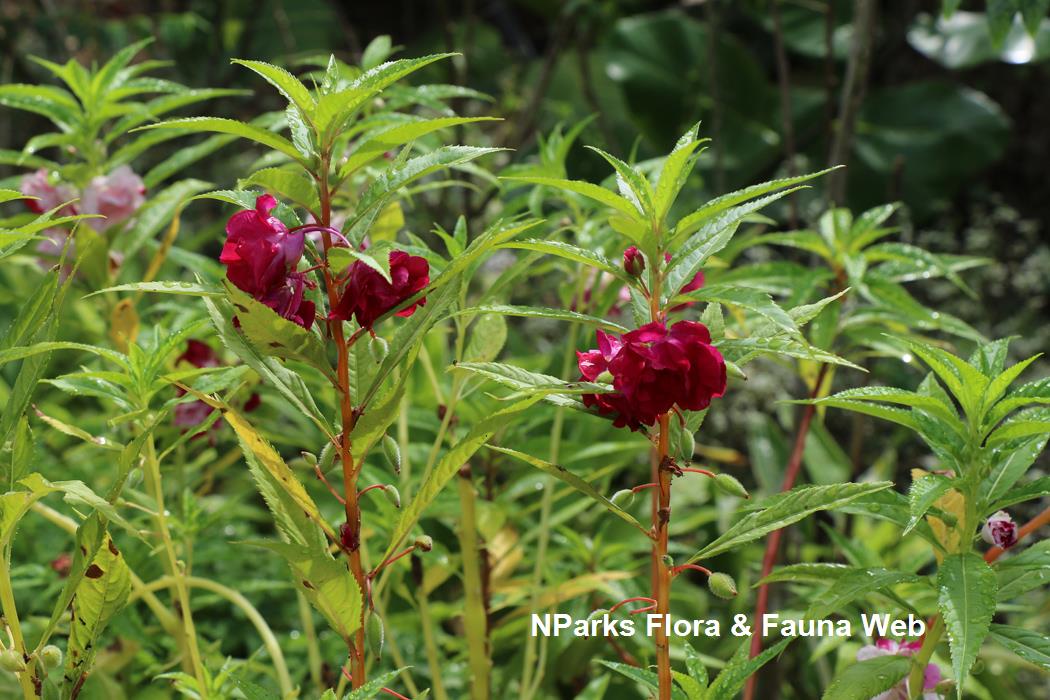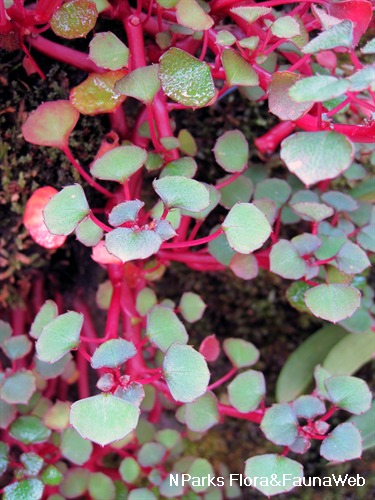
Back
Impatiens balsamina L.
| Family Name: | Balsaminaceae |
| Synonyms: | Balsamina balsamina (L.) Huth, Balsamina hortensis Desp., Impatiens balsamina var. vulgaris Wight & Arn. |
| Common Name: | Garden Balsam, Rose Balsam, Touch-Me-Not, Spotted Snapweed, 凤仙花, 指甲花 |
Impatiens balsamina or Garden Balsam is a annual herb that reaches to 1 m in height. Garden Balsam have elliptic to lance-shaped leaves with serrated margins and showy flowers that come in many colours; pink, red, purple. The genus, Impatiens is the latin word for impatient, referring to the explosive release of seeds from the fruit pod. They are easy to grow, tolerant of short periods of drought and with proper light, fertile well drained soil, the Garden Balsam thrives well in any gardens.
Name
Classifications and Characteristics
| Plant Division | Angiosperms (Flowering Seed Plants) (Dicotyledon) |
|---|---|
| Plant Growth Form | Herbaceous Plant |
| Lifespan (in Singapore) | Annual, Semi-Annual / Annual-Like |
| Plant Shape | Shrubby, Open |
| Maximum Height | 1 m |
| Maximum Plant Spread / Crown Width | 0.5 m |
Biogeography
| Native Distribution | Sri Lanka & India |
|---|---|
| Native Habitat | Terrestrial |
| Preferred Climate Zone | Tropical, Sub-Tropical / Monsoonal |
| Local Conservation Status | Non-native |
Description and Ethnobotany
| Growth Form | It is a sparsely-branched annual herbaceous plant and grows about 0.3 to 1 m tall. The plant produce tap root with numerous fibrous lateral roots. |
|---|---|
| Foliage | Its leaves are alternately arranged along the succulent stems, lanceolate-elliptic and have serrate margins. The leaves are about 4 to 12 cm long and 1.5 to 3 cm wide. |
| Flowers | Its flowers are showy and come in many colors (eg. red, pink, purple), produced in stalkless clusters in leaf axils. The spurs are incurved and about 1 to 2.5 cm long. |
| Fruit | Fruits are fuzzy capsules, green turning to brown when mature, and split open easily to scatter small seeds. |
| Habitat | It occurs as naturalised in rock outcrops in shaded areas within the Atlantic rainforest domain. It has also been naturalized in many countries around the world, appearing mostly in disturbed areas. |
| Cultivation | It grow well in evenly moist, organically rich, well-drained soils, tolerates dry and short periods of drought. |
| Etymology | The genus, impatiens is the latin word, impatient in references to the explosive release of seeds from the fruit pods. |
| Ethnobotanical Uses | Food (Fruit or Vegetable): Leaves and young shoots cooked and eaten as vegetable. Seeds edible raw or cooked. (Herb or Spice) Medicinal: The plant is used to treat pains in the joints. Leaf juice applied to warts. Mucilaginous flowers have cooling, antifungal and antibacterial properties, used to treat burns, scalds and snakebites. Powdered seeds given to women during labour to provide strength. Cultural / Religious: A dye can be obtained from flowers and leaves, used for dyeing fingernails and toenails. |
Landscaping Features
| Desirable Plant Features | Ornamental Flowers |
|---|---|
| Landscape Uses | Container Planting, Flowerbed / Border, Parks & Gardens, Small Gardens |
| Thematic Landscaping | Wildflower Garden |
Fauna, Pollination and Dispersal
| Fauna Pollination Dispersal Associated Fauna | Bird-Attracting |
|---|---|
| Pollination Method(s) | Biotic (Fauna) (Insects (Bee), Insects (Butterfly, Moth)) |
| Seed or Spore Dispersal | Abiotic (Explosive Dehiscence, Gravity) |
Plant Care and Propagation
| Light Preference | Full Sun, Semi-Shade |
|---|---|
| Water Preference | Moderate Water |
| Plant Growth Rate | Fast |
| Rootzone Tolerance | Fertile Loamy Soils, Easy to Grow, Moist Soils |
| Propagation Method | Seed, Stem Cutting |
Foliar
| Foliage Retention | Evergreen |
|---|---|
| Mature Foliage Colour(s) | Green |
| Mature Foliage Texture(s) | Thin |
| Foliar Type | Simple / Unifoliate |
| Foliar Arrangement Along Stem | Alternate |
| Foliar Attachment to Stem | Petiolate |
| Foliar Shape(s) | Non-Palm Foliage (Ovate, Lanceolate, Elliptical) |
| Foliar Venation | Pinnate / Net |
| Foliar Margin | Serrate / Toothed |
| Foliar Apex - Tip | Acute |
| Foliar Base | Cuneate |
| Typical Foliar Area | Notophyll ( 20.25cm2 - 45 cm2 ) |
Non - Foliar and Storage
| Stem Type & Modification | Herbaceous |
|---|---|
| Root Type | Underground (Tap Root) |
Floral (Angiosperm)
| Flower & Plant Sexuality | Bisexual Flowers , Bisexual Flowers |
| Flower Colour(s) | Pink, Purple, Red, White, Orange |
|---|
| Flower Grouping | Solitary |
| Flower Location | Axillary |
| Flower Symmetry | Asymmetrical |
| Individual Flower Shape | Bowl-shaped |
| Flowering Period | Free-Flowering |
| Flowering Habit | Monocarpic |
Fruit, Seed and Spore
| Mature Fruit Colour(s) | Brown |
|---|---|
| Fruit Classification | Simple Fruit |
| Fruit Type | Dehiscent Dry Fruit , Capsule |
| Mature Seed Colour(s) | Brown, Black |
References
| References | Hassemer, G. & Santos, A.P.d (2017), New records of naturalised Impatiens (Balsaminaceae) in Brazil. Magistra, 29(1), pp. 98-105. Cruz das Almas, Brazil. Missouri Botanical Garden (continuously updated), Helianthus annuus - Plant Finder. https://www.missouribotanicalgarden.org/PlantFinder/PlantFinderDetails.aspx?taxonid=277727. Accessed 13 January 2022. Royal Botanic Gardens, Kew (continuously updated). Plants of the World Online | Kew Science. https://powo.science.kew.org/taxon/urn:lsid:ipni.org:names:373978-1. Accessed 13 January 2022. |
|---|
Image Repository
Others
| Master ID | 826 |
|---|---|
| Species ID | 2121 |
| Flora Disclaimer | The information in this website has been compiled from reliable sources, such as reference works on medicinal plants. It is not a substitute for medical advice or treatment and NParks does not purport to provide any medical advice. Readers should always consult his/her physician before using or consuming a plant for medicinal purposes. |




















